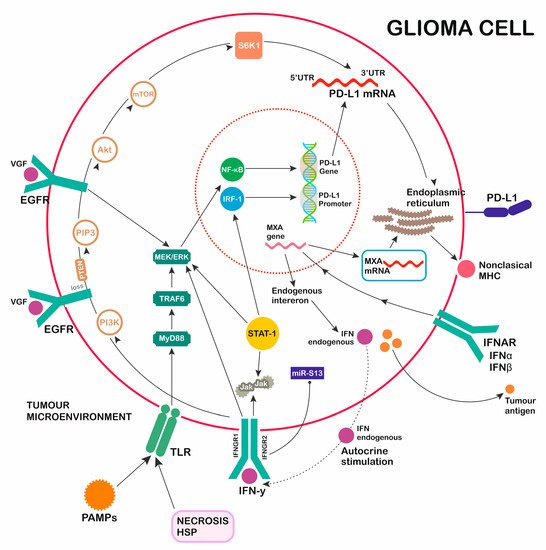3. PD-1 Ligand Expression—Role of TLR Activation
Toll-like receptors (TLRs) and agonists of receptors induce the immune response, activating many pathways, and cooperate with various antigens. TLRs are a conserved family of 10 receptors (TLR1–10) taking part in pattern recognition
[16]. Agonists of this group of receptors used to be called pathogen-associated molecular patterns (PAMPs). Their binding to specific TLRs initiates an immune response
[17][18]. Studies revealed that TLRs are endogenously expressed in glioma cells. The fact that TLR2, TLR4, and TLR9 activated by agonists promote tumor expansion and proliferation complicates the role of TLRs in the antitumor response
[19].
TLR agonists as microbial antigens, activating TLR receptors to initiate precise immunological activities. Agonists of TLR that have been studied include lipopeptides (TLR2, TLR6, and TLR1 agonists), lipopolysaccharides (TLR4 agonist), LPS, flagellin (agonists of TLR5), single-stranded DNA (TLR8 agonist and TLR7), double-stranded (ds)DNA (agonist of TLR3), and the DNA CpG motif (agonist of TLR9). Later studies showed that autocrine molecules released from dead and stressed cells such as heat shock proteins (HSP, for TLR4 and TLR2) and high-mobility group box 1 proteins (HMGB1, for TLR4 and TLR2) are also significant agonists. Many of them appear in glioma environment, causing tumor induced-activity of TLRs
[20][21].
In GBM cells, constitutive elevated expression of αB-crystallin, HSP27, HSP73, HSP72, and HSP90 was reported in vivo and in vitro as a result of endogenous induction. HSP–peptide complexes (HSPPCs) are able to interfere with various superficial receptors such as CD36, CD91, CD40, CD14, TLR2, TLR4
[22][23][24].
TLR activation in glioma cell results in signaling through two main pathways, one of which is myeloid differentiation factor 88-independent (MyD88-independent), and the other is myeloid differentiation factor 88-dependent (MyD88-dependent) (
Figure 2). The MyD88-dependent signaling cascade (MyD88/TRAF6/MEK/ERK) promotes early activation of cytokine transcription through NF-κB, supporting inflammatory processes and cytosolic enzyme and chemokine activity, and starts PD-L1 gene transcription. The MyD88-independent pathway leads to the late activation of NF-κB and interferon regulatory factors (IRF), which control the expression of type I IFNs and the activation of many gene promoters. Excreted Type I IFNs influence PD-L1 overexpression through IFNAR signaling activation, proving an indirect effect of the independent pathway
[25][26][27].
Figure 2. GBM induction of PD-L1 secretion. Multiple activation pathways (TLR, EGFR, IFNAR, IFNGR) promoting PD-L1 expression. 1. Toll-like receptors (TLR) pathway: pathogen-associated molecular patterns (PAMPs), NECROSIS, heat shock proteins (HSP) as activators of TLR myeloid differentiation factor 88 (MyD88)-dependent pathway signaling through TRAF6/MEK/ERK/NF-κB. 2. Epidermal growth factor (EGFR) pathway: TGFα/EGF/VGF/MUTATION OF RECEPTOR as activators of EGFR pathway signaling through MEK/ERK (STAT-1)/NF-κB. 3. IFNAR pathway: interferon (IFN)alfa, IFNbeta as activators of IFNAR pathway signaling through MXA gene transcription, forming nonclassical MHC, promoting PD-1L transcription, and the induction of endogenous interferons. 4. IFNGR pathway: IFNgamma as an activator of IIFNGR pathway signaling through JAK/STAT-1/MEK/ERK/IRF-1 and PI3K/PIP3/Akt/mTOR/S6K1, with a regulatory function over transcribed PD-1L mRNA.


